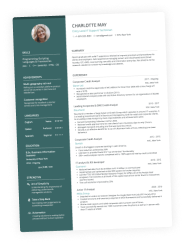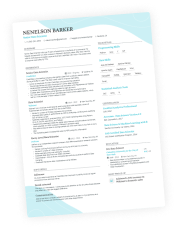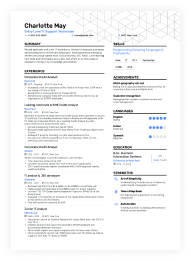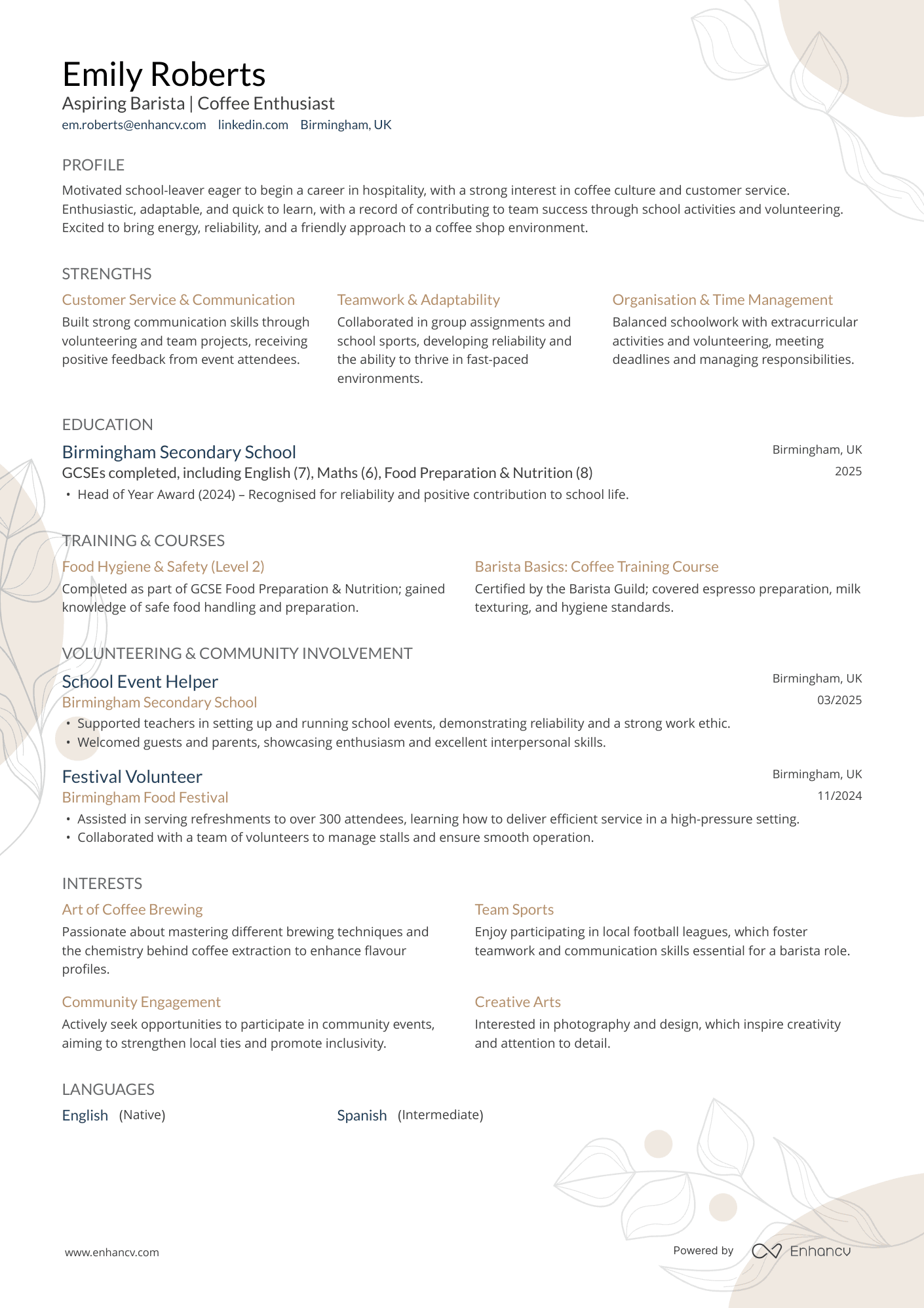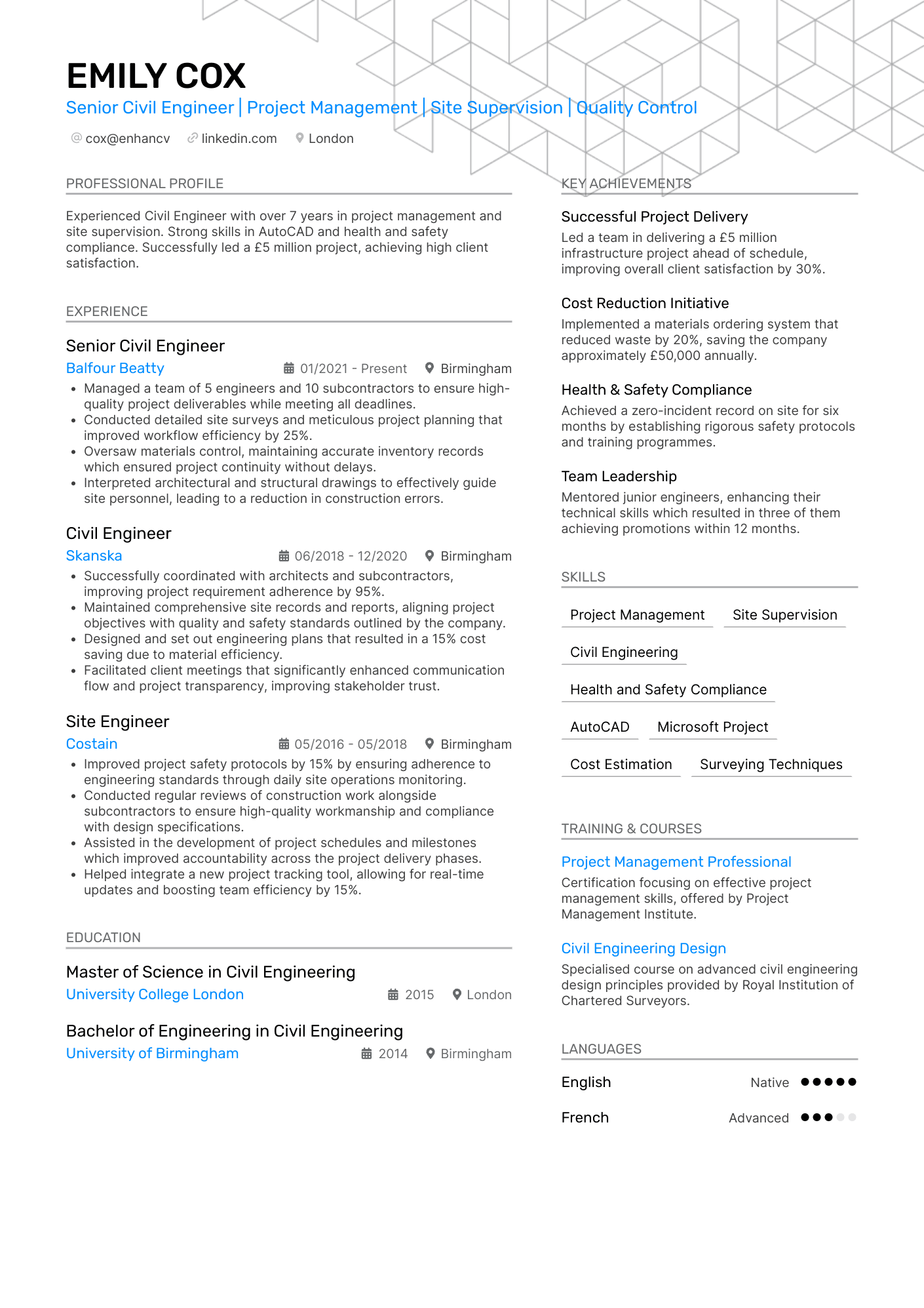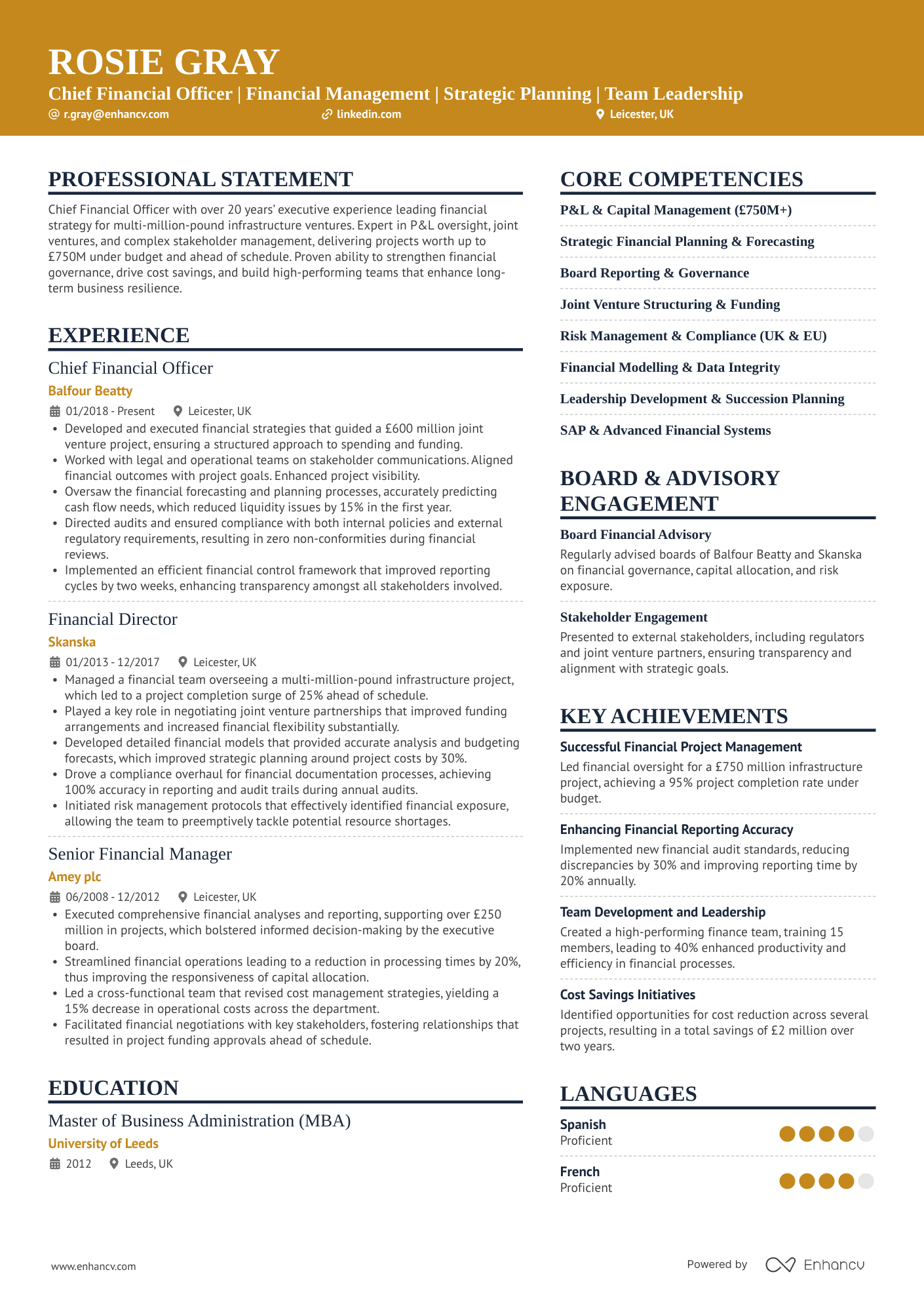It’s no secret that hiring managers are hard-pressed for time. When your CV lands in their inbox, chances are they’ll spend a matter of seconds deciding if you’re a “yes,” “no,” or “maybe”. To help you slide into that first category, you need to make their job easier. You can do that by getting the right sections in your CV.
Since many job seekers don’t know where to start with their CV sections, hiring managers have to contend with a wide array of applications that don’t hit the mark. Understanding what to include here (and, perhaps more importantly, what to leave out) is a snappy way to boost your chances of success. The aim is to make sure the recruiters can get all the information they need at a quick glance.
Luckily, you’ve come to the right place. This guide covers every essential CV section you need, what optional extras are worth adding into the mix, and which ones you should avoid.

Key takeaways
- Hiring managers need clear, well-structured CVs with defined sections, so they can quickly find the details that show you’re right for the role.
- Five core sections are essential for every CV: Header, Personal Statement, Experience, Education, and Skills.
- Tailor each CV section with job-specific keywords, action verbs, and achievements to stand out.
- How you organise your CV sections determines the format, whether reverse-chronological, skills-based, or combination.
- Optional sections, like Certifications, Volunteering, Awards, Languages, and Projects, add value only if relevant.
- Keep formatting simple and consistent for both human readers and ATS systems.
Not sure where to start? Enhancv helps you structure your CV professionally in minutes. If you already have a CV, upload it below and see whether it hits the mark.
Is your CV good enough?
Drop your CV here or choose a file. PDF & DOCX only. Max 2MB file size.
First up, let’s take a look at the main sections in a CV, and how you can write each of them.
What are the main sections of a CV?
There are plenty of sections you technically can include, but there are just five that are must-haves. The order of these core sections defines the format of your CV and directs the recruiter’s attention to what matters most for the job.
Structure is everything, or the most important after experience. Both humans and ATS tools rely on predictable formatting. If I can’t immediately see who you are, what you can do, and where you’ve done it, I’ll likely move on.
So the strong base is to have clear sections. This makes a candidate stand out more than any design trick.
British recruiters have similar expectations when it comes to CVs. Including the following key elements is a smart way of making sure you align with them:
- Header: This is where you include your contact details and any extra links.
- Personal statement: Similar to an elevator pitch, this short statement gets the reader’s attention.
- Experience: Often the bulk of your CV, especially if it’s in a chronological format.
- Education: The details of your formal education.
- Skills: Strengths and talents that make you right for the role.
Of course, there are extra CV sections you can add (should you have the space!), but these are the foundational elements. Ensuring that all of the above is on the page is the best way to get started.

Clear sections work for software and human readers!
Why is a clear structure so important? We’ve got two reasons.
First up, this makes it simple for the hiring manager (or anyone else, for that matter!) to follow.
The second reason is that having clear, well-labelled sections makes it easier for ATS software to parse your CV correctly, so your skills and experience aren’t missed during the initial screening.
Ready to start writing your CV from scratch? In the next part, we’ll move onto the essential CV sections that every job candidate needs to have.
5 essential CV sections: the must-haves
If you’re creating a CV, the first thing you need to do is know what the must-have sections are. We’ve already gone over these briefly, but now let’s take a closer look at each of them, along with some handy examples, too.
1. Header
Your CV header sits at the top of the page, and includes your basic contact details along with extra links that add real value to your application. Above all else, this part of your CV needs to be scannable. Rather than confronting the reader with a block of text, it should be simple lines of information.

What to include in your header
- Full name: Start by writing your first and last name.
- Job title: Next, include the title of your most recent role.
- Professional email: List an email address you use professionally. If in doubt, choose one that features both your first and last name, or initials.
- Phone number: Add a phone number that you use regularly. This can be your mobile number. Just make sure the answerphone message is suitable for work.
- Location: You don’t need to write out your whole address. In fact, doing so can look old hat. Instead, add your city (or town) and postcode (or country). If you’re willing to relocate for work, make this clear by adding a note here.
- LinkedIn (optional): If you use LinkedIn and it matches your CV, you can insert a hyperlink in the header.
- Portfolio or website (optional): For people in creative industries, like writing or design, it may be smart to insert a link to your online portfolio. Similarly, if you have a professional website, you might want to add a link here.
Understanding what to include is one thing, but what about what not to include? Keeping your CV free from clutter and ditching unnecessary details is also an important part of the process.

What to leave off your header
- Full address: This can lead to potential discrimination based on your location or even data protection issues. It also looks old-fashioned.
- Photo: It’s not standard practice in the UK to add a photo to a CV. In fact, doing so can lead to unconscious bias from a recruiter.
- Date of birth: Revealing this at the top of your CV can lead to age discrimination. Aside from that, it has no relevance to whether you can do the job at hand.
- “Header” title: You don’t need to label this section in your CV.
Make sure you keep the style and design simple. Let’s take a look at a copyable example below:
Example of a UK CV header
JAMIE MORGAN
Digital Marketing Manager
Tel: 07456 789 0XX | Email: jamie.morgan@email.com
Portfolio: website.co.uk |LinkedIn: linkedin.com/in/fullname | London, UK
Often enough, the CV header is the first thing you’ll write. You can use this as part of your master CV as the details will rarely change. When you’ve completed it, it’s time to move onto your personal statement.
2. Personal statement
Your personal statement is the first thing employers see on your CV. Sitting right under your contact details, it gives a quick snapshot of your value in just three to five sentences.
This short introduction should feature your most compelling attributes and convince the hiring manager you’re the right fit for the role. It’s worth spending the time to get it right—it may well be the first thing they read.
In the US, this section is often called a summary or an objective, but in the UK both are covered by the simpler term “personal statement.” UK job seekers applying abroad—and international candidates targeting the UK—should be mindful of these regional differences.
Once you know where it goes and what it’s called, the next step is to decide whether to write a summary or an objective.
Here’s a breakdown of which one’s which:
- Summary: A career snapshot for experienced professionals. This one looks backwards at all you’ve done and shares your top achievements.
- Objective: A statement for students, graduates, or career changers. This one looks forwards and tells the hiring manager what you plan to do.
Pick the right type of personal statement based on how much experience you have.
Objective statement
If you’re a student, recent graduate, or changing careers, you might come across advice to write a CV objective. This section traditionally outlined your skills, achievements, and career goals. However, many recruiters now consider objectives outdated—after all, it’s obvious your goal is to get a job. That said, an objective can still work if you use it to highlight transferable skills and show genuine enthusiasm for the field you’re entering.
If in doubt, it’s smarter to take the summary approach instead. You can still add a line about your future goals, but the meat of the statement should be based on your skills, education, or experience.
Let’s take a quick look at an example of how a CV objective would look:
Objective
Recent psychology graduate with strong research and analytical skills, including experience conducting a thesis project on cognitive development. Eager to apply evidence-based approaches and critical thinking in a professional environment. Seeking a role to gain hands-on experience and contribute to projects that align with long-term career goals in research and applied psychology.
Mentioning any specialisms is clever if you’re a student or graduate. This move shows the reader where your niche lies, and gives them an idea of your experience. If you want to get some extra brownie points, you can also slide in details of any projects you’ve worked on or awards you’ve won.
Summary statement
Most professionals will write a summary statement rather than an objective. This is a short paragraph that details your biggest career wins to date. To get started, consider what your unique selling position (USP) is. What is it that makes you different from other candidates?
Here are some things you might include:
- Years of experience: Kicking things off with how many years of experience you have lets the hiring manager know what level you’re at.
- Notable wins: Detail your biggest achievements and, where possible, include metrics to back them up.
- Specialisms: Do you have a special talent or an in-demand skill? Make that central to your summary if you want to stand out.
- Awards: If you’re quite literally “award-winning,” now’s the time to shout about it. Let the hiring manager know what awards you’ve gained at the top of your CV.
You don’t have to use all of the above. Figure out what works best for you.
Here’s an example of how a well-written summary statement may look:
Summary
Project Manager with 7 years of experience delivering large-scale IT and infrastructure projects on time and within budget. Proven track record of leading cross-functional teams of up to 20 people, achieving cost savings of 15% through process improvements, and implementing agile practices that reduced delivery times by 25%. Recognition as ‘Employee of the Year’ in 2022.
Don’t write an essay. The hiring manager wants to see a bite-sized explanation of your value. The more concise you can make it, the more likely they are to read and digest the whole thing.

Use language to your advantage!
No one likes to read dull writing. Sprucing up your personal statement with action verbs and a few carefully chosen adjectives can make a big difference. Action verbs show what you did, while adjectives add colour to how you did it. The key is to keep them strong and specific, not generic fluff like “hard-working” or “motivated.”
Here are some examples you can borrow for your CV:
Action verbs:
- Delivered
- Transformed
- Oversaw
- Exceeded
- Beat
- Guided
- Mentored
- Negotiated
- Tracked
- Audited
- Tested
- Engineered
Adjectives (used sparingly to support your achievements):
- Strategic
- Innovative
- Analytical
- Adaptable
- Proactive
- Collaborative
- Resilient
- Dynamic
Tailor your CV opening statement for the job advert—just like every other section.
Avoid a one-size-fits-all approach. Instead, customise your profile to match the requirements of the role you’re applying for.
Review the job advert and highlight keywords or phrases, then weave them naturally into your statement. This helps ATS software parse your CV correctly and makes it easier for the hiring manager to spot your fit at a glance.
When you’re pleased with your personal statement, you can get cracking on your work experience.
3. Work experience
Your work experience is a detailed overview of your career history. However, one of the biggest mistakes candidates make is whacking every job they’ve ever held onto the page.
It’s your job to curate a compelling career story. Position yourself as just the candidate the hiring manager has been looking for. You can do this by identifying your most recent and most notable work successes, and emphasising that.

What to include for each position
- Job title: Start with your official title as it appears on your contract.
- Employer: Your company’s full name.
- Dates: When you started and finished, using month and year (e.g. May 2021 – June 2023).
- Location: Only the city or town, not the full address. Add if you are willing to relocate.
- Achievements: Bullet-point your key accomplishments, backing them up with numbers where possible.

Start with your most recent job!
List your current or latest role first, then move backwards through your work history. This format is called reverse-chronological order, and it’s the standard that UK hiring managers and ATS expect.
As a general rule, your work experience CV section should go back 10-15 years in the past, or list your most recent three to four jobs. This gives the hiring manager enough to go on. They can quickly review your CV and determine whether you have the right background for the job.
When writing your CV experience section, remember to focus on your achievements, i.e., the end result of your work, rather than the tasks or duties alone.
If you’re unclear on how to get this right, we have a simple formula you can use—STAR:
- S (Situation): Briefly set the context. What was happening, or what challenge did you face?
- T (Task): Explain your responsibility or the goal you needed to achieve.
- A (Action): Describe the specific steps you took to handle the task or problem.
- R (Result): Share the outcome, ideally with numbers or a clear impact.
Following this structure when you craft each sentence means that the hiring manager will never be left guessing about the tangible impact you had.
Take a look at our example work experience section for inspiration:
Work experience example
Office Manager
Brighton & Hove Legal Services, Brighton, UK
Jan 2018 – Present
- Introduced a filing system that cut document retrieval times by 40%, improving efficiency.
- Coordinated office relocation for a team of 30 staff with no downtime to operations.
- Trained three administrative assistants, leading to a 20% increase in team productivity.
Administrative Assistant
South Coast Insurance, Brighton, UK
Mar 2014 – Dec 2017
- Streamlined client onboarding, reducing average processing time by two days.
- Managed high-volume email communications, supporting a customer base of 500+.
- Organised quarterly review meetings, ensuring accurate reporting and timely delivery.
Receptionist
City Medical Practice, Brighton, UK
Sep 2010 – Feb 2014
- Scheduled an average of 60 patient appointments per day, ensuring smooth operations.
- Implemented a reminder system that reduced no-show appointments by 15%.
- Recognised with a staff award in 2013 for outstanding service and teamwork.

PRO TIP
But wait, what if you’re an entry-level candidate or someone with no experience?
You can still include an experience section. However, the positions you add may not be traditional roles. Consider including voluntary positions, part-time work, or any freelance projects you may have worked on.
Of course, if you have zero experience, you can omit this section and opt for a skills-based CV format, which shifts the focus away from your work history.
Once you’ve completed this section in your CV, the next one that deserves your attention is your education.
Let us show you how to craft yours.
4. Education
Your education section deserves a prime spot on a UK CV. However, where you place it depends on the format you’re using.
If you’re going for a chronological format, you should position your education section below your work experience. For a skills-based (functional) format, you can place it above your work experience to draw attention to competencies and achievements gained through formal training.

What to list for each education entry
- Qualification or certificate: Lead with the full name of the qualification, along with any special accreditations that it holds. For example, “BA in Journalism with Hons”.
- Institution: That is, your school, college, university, or any other educational provider.
- Date: List the date that you completed the qualification at hand (the year is enough).
- Grades: What grade you got overall, e.g. “2:1” or “A,” so long as it’s above average.
- Awards or modules (optional): When relevant, you can detail any awards or modules that are likely to make your application stand out.
While this CV section is important, it’s often brief. You don’t need to go into minute detail about your schooling. That will only waste space. Instead, stick to the facts and let your grades speak for themselves.

Can you leave out certain qualifications?
When you’re short on space, you might be looking for ways to condense your education section. The best approach is to leave off older qualifications if you have more impressive ones to highlight.
So, if you’re a mid-level professional, you may have multiple degrees and certificates. Omit your GCSEs and A Levels, unless they’re extremely relevant.
If you’re still studying, you can list your ongoing qualification. Just make sure that it’s obvious you’ve yet to complete it. Should you have a projected grade in the bag, there’s no harm in adding that, too.
Here’s an example of how a student education section could look:
Education section example for students
BA (Hons) English Literature, 2:1 (projected)
University of Leeds, Leeds, UK
Ongoing
- Completed dissertation on “Contemporary Women Writers and Identity in Post-Brexit Britain.”
- Relevant modules: Critical Theory, Modernist Literature, Creative Writing.
A Levels
Leeds City College, Leeds, UK
2020
- English Language (8), History (8), Sociology (7).
GCSEs
St Mary’s High School, Leeds, UK
2018
- 9 GCSEs at grades 9–7, including Maths and English.
And now, let’s check out how a professional’s education section could look:
Education section example
MSc Human Resource Management
University of Manchester, Manchester, UK
2016
BA (Hons) Business Administration, 2:1
University of Birmingham, Birmingham, UK
2014
Level 5 Certificate in HR Management
Chartered Institute of Personnel and Development, London, UK
2018
Now that your experience and education have set the scene, let’s spotlight your skills.
5. Skills
The skills section of your CV details your most valuable talents that align with the job you’re applying for. While you can mention your skills in other sections—most notably in your work experience and personal statement—this is a dedicated place to highlight your top talents.
You should include a mixture of both hard skills and soft (or transferable) skills, but make sure you lead with the former.
Hard skills come first. They’re what ATS systems flag and what managers want to see straight away.
Soft skills are important too, but show them through examples in your work history rather than listing them as buzzwords.
How to craft an effective skills section
To make sure your skills section packs a real punch, follow these tips:
- Review the job description: Take a look at the core criteria, and see which skills the hiring manager requires. Make sure that the ones you have are prominent in this section.
- Don’t use synonyms: If the job advert asks for a “scheduling,” saying “planning” instead could mean that the hiring manager or ATS misses your point. Be specific and use the same words.
- Bullet-point each of your skills: Put them in order of priority. For soft skills, you may want to add a line explaining how you use the skill.
- Add in a proficiency level (optional): This gives the hiring manager an accurate idea of how much you’ve honed a certain hard skill.
Check out our example of a great skills section below:
Skills on a CV
Hard skills
- Project scheduling (Advanced)
- Data analysis with Excel & Power BI (Advanced)
- Budget management (Intermediate)
- HR systems: Workday & SAP (Intermediate)
- Report writing & compliance documentation (Advanced)
Soft skills
- Team leadership – managed cross-functional teams of up to 12 people
- Client communication – led regular stakeholder update meetings
- Problem-solving – implemented process improvements that cut admin time by 20%
You’re well-versed in the main CV sections, but what about any optional extras?
Next up, we’ll take a look at some sections you can include to strengthen your application.
Bonus: optional CV sections to include
Let’s say you’ve completed all of the above, and you still have space. While we’ve covered the essential CV sections, there are plenty of extras you can use to make your application stand out.

PRO TIP
Only include what adds value!
Before sliding an extra section onto your CV, ask yourself one question: Does this add something valuable to my application? If the answer is no, you may be better off leaving it out.
Cramming in irrelevant information won’t land you the job. In fact, if it makes your CV look overly busy or confusing, this choice could end up doing more harm than good.
Let’s dive into some of the optional extra sections for your CV:
Certifications & training
Professional certificates aren’t always the same as your foundation education. If you’ve undertaken job-specific courses or completed training programs, they may deserve their own CV section.
Follow a similar format to your education section, listing the certificate name, the institute or course provider, the completion date, and your grade, if applicable.
Here’s an example of a certificate section you could create:
Certifications and training on a CV
PRINCE2 Practitioner Certification
AXELOS Global Best Practice, Completed 2022
Google Data Analytics Professional Certificate
Coursera (Google Career Certificates), Completed 2021
CIPD Level 5 Certificate in Learning & Development
Chartered Institute of Personnel and Development, Completed 2019
Dedicating a whole section to certificates is useful if you’ve got a few in the bank. The hiring manager will see that these are separate to your basic education and more aligned with the role.
Volunteering
When you lack work experience, volunteering roles can help to fill the gap. Should you have a few, you can dedicate a whole CV section to these positions.
Lay this out like you would your employment section, with the title, company (or charity), your dates of work, and any notable achievements below.
Check out our example for some guidance:
Volunteer experience CV example
Event Coordinator
Cancer Research UK, Manchester, UKJan 2022 – Present
- Organised monthly fundraising events attracting 200+ attendees and raising over £15,000.
- Recruited and trained 10 new volunteers to support events.
- Managed logistics, supplier contracts, and social media promotion.
Teaching Assistant
Barnardo’s Youth Centre, Manchester, UKSep 2020 – Dec 2021
- Assisted with after-school literacy programmes for children aged 7–11.
- Created lesson resources and supported group reading sessions.
- Helped improve average reading comprehension scores by 12% over the term.
Only got one notable volunteer role? You can merge it into your work experience section for ease. However, make sure you make it clear that it was volunteer and not paid work.
Awards
Do you have more awards than your mantlepiece can hold? While you can list some awards in your education or the relevant job section, there is another way to go: Popping an awards section at the bottom of your CV. Keep this brief and to the point, including the award name, the body, and the date you got it.
Here’s how your awards section might look:
Awards
Outstanding Volunteer Contribution
Barnardo’s Youth Centre, 2021
Regional Public Speaking Champion
Young Speakers Network, 2019
There’s no need to add extra context, when the awards do the heavy lifting. Simply mentioning them here can open up a talking point if you’re invited to a formal interview.
Languages
Speaking a second, or even a third, language can be a major bonus. This is especially valuable when you’re applying for a position at a multinational company. Create a language section and be clear about your abilities. You can use the CEFR framework to be specific about your level, for example.
Let’s see how this section could look:
Languages
- English – Native
- Spanish – B2
- French – A2
Of course, if you have any formal certificates in languages—such as an A Level, an Italian CILS, or a French DELF—you should add these to your education or certificate section.
Projects or publications
For journalists, academics, and creatives, showing off projects and publications can be a real win. Hiring managers are likely to be impressed by big brand names you’ve worked with or journals you’ve been published in. Why not create a brief section that covers these neatly?
Here’s an example of what we mean:
Example of publications on a CV
Article: “The Rise of Sustainable Fashion”
Published in The Guardian, March 2023
Research paper: “Cognitive Bias in Decision-Making”
Published in Journal of Experimental Psychology, June 2022
If you want to take things to the next level, you can hyperlink your published work. This makes it easy for the hiring manager to review it in just one click.
Hobbies & interests
Hobbies and interests can humanise your application, showing the hiring manager that you’re more than a list of experience and qualifications. However, getting the balance right here can be rather tricky.
Hobbies and interests are a double-edged sword. They can remind us there’s a real person behind the CV and sometimes spark conversation.
But they should never take space away from professional achievements. Include them only if relevant, for instance, a developer contributing to open-source projects.
The golden rule is to only add hobbies and interests if they add value to your application. If these pastimes say something interesting about your ability to do the job, by all means list them. If, on the other hand, they don’t have anything to do with the role or look “fluffy,” you may be better off omitting them.
Let’s take a look at an example of what not to include:
Don’t put these hobbies on your CV
- Watching TV
- Listening to music
- Going on holiday
- Reading books
- Hanging out with friends
These activities are generic and unimpressive. Putting them on your CV uses up valuable space that you could reserve for your achievements. It’s far better to detail interests that make you look professional and are aligned with the job you want
Check out a better hobbies and interests section below:
Good hobbies and interests to put on a CV
- Open-Source Software Contribution
- Marathon Running
- Public Speaking & Debate Club
- Community Volunteering
Sharing hobbies that make you look like a strong leader (such as public speaking) or a team player (like community volunteering) is savvy. These interests frame you as a capable professional.

CV sections to avoid (or handle differently)
- References: You might have been taught to include references on your CV, but that is an outdated practice. If you must, just say “available on request”.
- Salary expectations: There is no need to go into this on your CV. If you have a number in mind, that’s great. Save it for the interview.
- Overstuffed soft skills: A long list of soft skills is unlikely to impress a discerning hiring manager. Focus on the skills that will land you the job.
By this point, you should be feeling pretty confident in choosing the right CV sections. However, getting the formatting right is a must. In the next part, we cover what you need to know with examples.
How to organise your CV sections
As we’ve mentioned, the CV format you choose depends on your career level, or whether you’re trying something new. Make sure you get this part of the puzzle right.
If you’re new to the working world or this particular field, go with a functional format. This positions your skills and education higher than your work experience. Freelancers, creatives and career changers might find this format especially useful, as it doesn’t follow the traditional linear structure.
Should you be a mid-level professional, you can opt for the standard reverse chronological order. That means that your work experience is higher than your education on the page. This is a firm favourite for both ATS systems and hiring managers alike.
How to format your CV for the ATS and hiring managers
Don’t try to be flashy with your CV design. The best structures are simple and easy to read. To make the whole thing a cinch, use one of our tried and tested professional CV templates. We’ve created these with the ATS in mind, which means they can securely pass every AI scan.
Overcomplicated designs with graphics or unusual titles confuse both recruiters and ATS systems. Keep it easy to read.
Whether your CV gets read by ATS software or a hiring manager, one thing is for sure: it needs to be simple. Making sure that either a bot or a human can quickly scan your application is the key. Keep sections clear and labelled correctly, and formatting consistent.
Clarity always beats visuals. A neat, well-organised CV with consistent fonts and simple formatting works best. Recruiters often spend less than 30 seconds on a first read, so quick access to skills, recent roles, and results is far more powerful than any design element.
Follow this guidance, and you should have no problem creating an interview-winning CV. For some creative inspiration, we’ve got a selection of CV examples up next.
3 example CVs by career stage
Wondering how your CV sections will look on the page? You don’t need to. Take a quick peek at one of our CV examples below, listed based on each career stage.
Entry-level or student CV example
For entry-level or student CVs, the focus should be on any education and transferable skills you have. Make it clear that you’re new to the industry, but show a real willingness to learn.
Mid-level CV example
If you’re already climbing the career ladder, be sure to highlight your progression so far and any notable achievements. Frame this next step as a logical part of your career journey.
Senior or executive CV example
When you’re high up in your career, you should be emphasising your leadership skills, the impact of your work, and your ability to strategise. Show how far you’ve come and provide proper metrics.
As you can see from our examples, the length and style of your CV will change depending on how long you’ve been in the industry. Ensure your structure suits your career level for the best results.
Do you have some final burning questions? We’ll be covering them now.
Frequently asked questions about CV sections
Looking for some more answers? Read our frequently asked questions (FAQs) below:
How many sections should a CV have?
The answer depends on your career level. However, most professionals should include the five core CV sections we’ve covered in our guide.
Do I need a hobbies section?
No, you don’t need a hobbies section. But you can include one if your interests genuinely add value to your application. For instance, Enhancv offers a unique My Time section, where you can show how you divide your daily activities in a pie chart.
Should my CV be one or two pages?
Most CVs are between two pages long, but there are some notable exceptions. Read our comprehensive guide on CV length to learn more.
Can I use Europass in the UK?
Europass CVs are accepted in the UK, but they’re not the standard. Submitting this type of CV could make you stand out for all the wrong reasons. If you want to boost your chances of landing an interview, tailor your CV to meet the UK standards.
Conclusion
British hiring managers expect to see the same CV sections when reviewing applications. Starting out with the essential sections is a good idea, as it means they won’t get any unwanted surprises. Once you’ve done that, you may consider throwing in a few bonus sections if they genuinely enhance your application. Why not get started now by using our simple drag-and-drop CV Builder Tool?

